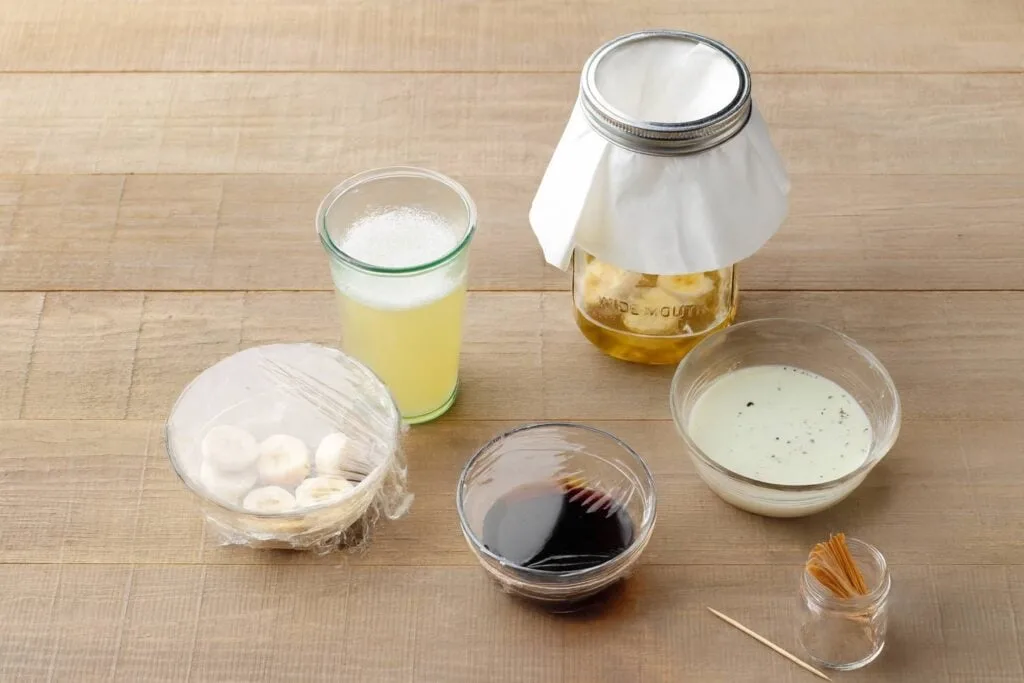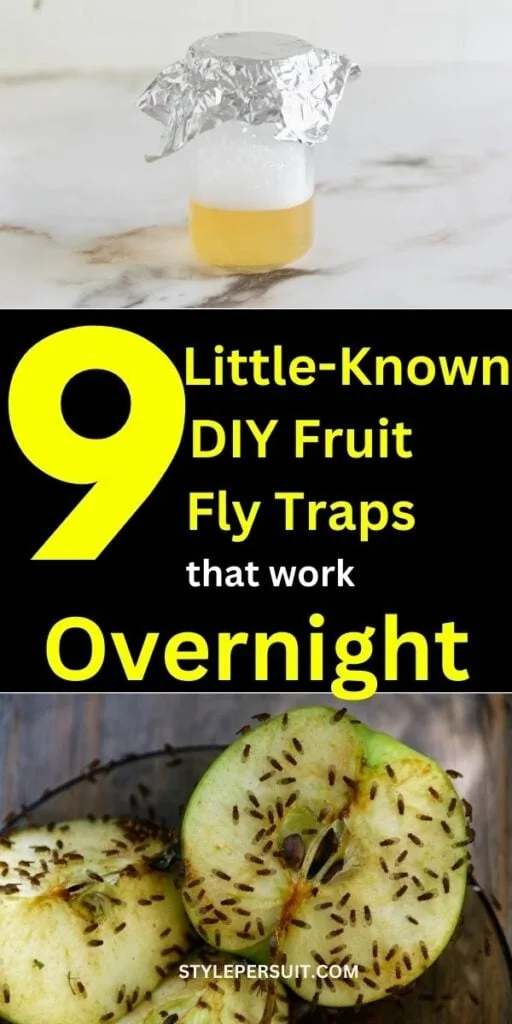They come out of nowhere. One day your kitchen feels normal, and the next it’s like you’re running an international airport for fruit flies.
They’re buzzing over the bananas, doing fly-bys around your wine glass, and somehow sneaking into your bathroom even though you don’t remember leaving fruit in there.
And the worst part? No matter how many you swat, they seem to multiply behind your back.
You take out the trash, scrub the counters, even yell at them like that’s going to help, and yet, there they are, hovering smugly over your compost bin.
Here’s the good news: you don’t need a chemistry degree or a trip to the hardware store to deal with them.
With a few household items and about five minutes of effort, you can outsmart those freeloaders.
Think of it as kitchen pest control meets DIY science fair, simple, a little messy, but surprisingly satisfying.

Why Fruit Flies Love Your Home
Fruit flies (Drosophila melanogaster) are obsessed with fermentation. They’re not really after the fruit itself, they’re after the yeast breaking it down.
To a fruit fly, a ripe peach is like a bakery that never closes.
And they’re not picky. Fermenting juice, a forgotten beer bottle, even the sticky rim of your trash can it all smells like paradise.
What makes them extra irritating is their breeding speed.
A single female can lay up to 500 eggs, and those eggs hatch into larvae within 24–30 hours.
A week later, they’re adults, and the cycle starts again. That’s why you go from “Eh, just a couple of flies” to “Why does my kitchen look like a fruit fly convention?” seemingly overnight.
And yes, they really do come out of nowhere. Technically, the eggs probably hitched a ride on your bananas or apples from the grocery store.
You didn’t “cause” the infestation fruit flies just know how to make themselves at home.
The Simple Science of DIY Traps
Every fruit fly trap, no matter how fancy or homemade, works on the same principle:
- Attractant — something they can’t resist (fermenting sugars, vinegar, wine, fruit).
- Trap mechanism — a way in, no way out.
That’s it. Think of it like opening a bar with free drinks but locking the door behind your guests. They’ll rush in, have the time of their (very short) lives, and never find the exit.
Once you see it that way, DIY traps feel less like science experiments and more like clever kitchen hacks.
Let’s go through the classics four classic traps that actually work, plus a few smart tweaks to make them even better.
Trap #1: The Vinegar & Soap Cup
This one’s the MVP because it’s fast, cheap, and weirdly satisfying. Grab a small jar or bowl, pour in a splash of apple cider vinegar, and add a single drop of dish soap.
That’s it. The vinegar draws them in, and the soap breaks the surface tension so they can’t land gracefully on the liquid, they sink and drown.
The first time I tried this, I set the jar next to my fruit bowl and went about my evening.
By the next morning, a dozen tiny bodies were floating in the amber liquid, like some morbid little aquarium. Gross? A little. Effective? Absolutely.
Why it works: Apple cider vinegar smells like fermenting fruit, which is basically catnip for fruit flies.
Without soap, they’ll land and buzz away. With soap, it’s game over.
Pro tips:
- Use a shallow glass jar or even an old candle jar, it gives more surface area for flies to land.
- Refresh the vinegar every 2–3 days. Once it smells dull to you, it’s no longer irresistible to them.
Amazon Helpers:
- Bragg Organic Apple Cider Vinegar — the classic, unfiltered, mother-included vinegar fruit flies can’t resist.
- Seventh Generation Dish Soap — eco-friendly, smells nice, and works perfectly for that surface-breaking magic.
Trap #2: The Plastic Wrap Jar
If you’ve got cling wrap and a toothpick, you’ve got yourself another deadly design.
Pour vinegar, wine, or mashed fruit into a jar, cover the top tightly with plastic wrap, and secure it with a rubber band.
Poke a few small holes with a toothpick, and you’re done.
Here’s what happens: the flies crawl through the tiny holes, lured by the smell of fermentation.
Once inside, they can’t figure out how to get back out. It’s almost sad to watch.
Why it works: It’s a one-way street. Their sense of smell leads them in, but their not-so-stellar problem-solving skills keep them stuck.
Pro tips:
- Don’t make the holes too big, you want them to squeeze in, not strolling in.
- If you’re running multiple traps, experiment: one with vinegar, one with wine, one with fruit. You’ll quickly learn which bait your local flies love most.
Amazon Helpers:
- Glad ClingWrap — stretches tight, pokes clean holes, doesn’t sag.
- Ball Mason Jars — sturdy, reusable, and way more aesthetic than a stained coffee mug.
Trap #3: The Funnel Trap
This one feels a little more “science fair,” but it’s just as effective. Take an empty wine bottle (yes, finally a reason not to rinse it right away), pour a splash of leftover wine or vinegar inside, and roll a piece of paper into a funnel.
Tape it into the bottle’s opening.
The flies smell heaven, fly down the funnel, and then can’t figure out how to get back up. It’s genius in its simplicity.
I remember the first time I tried this I set the bottle on my counter, and within half an hour, I could see little shadows zipping inside. By morning, it was like the wine bottle had a whole new vintage called Château de Fruit Fly.
Why it works: Funnels are a natural “in but not out” design, and the tall bottle walls make escape nearly impossible.
Pro tips:
- Don’t overthink the funnel cheap printer paper works fine.
- Tape around the funnel’s edge so flies can’t squeeze back out the sides.
Amazon Helpers:
- AstroPaq Reusable Wine Bags — if you don’t have bottles handy, these work well as bait containers.
- Amazon Basics Printer Paper — for quick DIY funnels that you won’t feel bad tossing afterward.
Trap #4: Homemade Sticky Traps
Not everyone loves the idea of a jar filled with floating fruit fly corpses. If that’s you, sticky traps are another solid option.
Cut strips of cardstock, smear them with honey or Vaseline, and hang them near your problem areas.
The flies land, get stuck, and that’s that.
I’ll be honest: they’re not pretty. But if you’re desperate or just want to see exactly how many flies you’re catching, they’re effective.
Why it works: Flies can’t resist landing on nearby surfaces, and sticky strips make sure they don’t leave.
Pro tips:
- Replace them often, and they get gross fast.
- If the DIY mess isn’t your thing, grab pre-made sticky traps for a neater alternative.
Amazon Helpers:
- Catchmaster Yellow Sticky Traps — affordable, pre-made, and way less sticky-finger drama.
- Reynolds Freezer Paper — a great base if you prefer making your own strips.
The Best Baits: What Really Works
Fruit flies aren’t gourmet, they’re opportunists. But some baits are undeniably better:
- Apple cider vinegar: the #1 choice for good reason.
- Red wine: leave a little in the bottle flies will find it before you finish your next pour.
- Overripe bananas or peach scraps: almost unfair how fast this works.
- Kombucha or beer: fermentation heaven.
Funny aside: kombucha brewers actually joke about “fruit fly starter cultures.” It’s not entirely a joke they’ll swarm an open SCOBY jar like it’s Coachella.
Where to Place Your Traps
Placement is half the battle. Put traps where flies are already congregating near the fruit bowl, trash, compost bin, or sink drains.
If you notice them around a specific spot (like the recycling), that’s your hotspot.
One thing I learned the hard way: don’t put traps next to fresh fruit. You’re basically offering them two restaurants, and the fruit usually wins.
Prevention: Because Traps Alone Aren’t Enough
DIY traps are great for catching the flies you already see, but prevention is what keeps you from waking up one morning to find a brand-new swarm buzzing over your fruit bowl.
Think of traps as damage control and prevention as insurance. You need both.
A few simple habits make a world of difference:
- Refrigerate ripe fruit. Yes, it might feel weird putting bananas in the fridge (they go brown on the outside), but the fruit inside stays fine, and flies can’t get to it.
- Rinse bottles and cans before recycling. Even a splash of soda or beer is enough to keep flies fed for days.
- Take compost out daily. If you’ve ever lifted the lid on a week-old compost bin, you know why. Fruit flies consider it a honeymoon suite.
- Clean your drains. Sink drains are sneaky breeding grounds because bits of food stick inside. A kettle of boiling water once or twice a week works wonders, or you can go heavier with baking soda + vinegar.
- Check for forgotten messes. That half-empty juice box under the couch? Yeah, the flies will find it before you do.
Mistakes People Make (And How to Avoid Them)
The good news: fruit fly traps are simple. The bad news: little slip-ups can make them almost useless. Here’s where people often go wrong:
- Using the wrong vinegar. White vinegar smells sharp to us, but fruit flies couldn’t care less. Apple cider vinegar, red wine vinegar, or actual wine are much more effective.
- Forgetting the soap. Without dish soap, the vinegar trap just becomes a happy hour spot where flies land, sip, and leave. Soap breaks the surface tension so they sink.
- Setting traps next to fresh fruit. If you give them a choice between an all-natural peach and a jar of vinegar, guess what wins? Always remove or cover fresh produce before setting traps.
- Not refreshing bait often enough. Vinegar loses potency after a couple of days, especially in warm weather. If you’re not catching much, swap it out it’s like changing the batteries in your fly-catching system.
A little attention to these details means the difference between a trap that works like magic and one that’s just another jar on your counter.
Final Thoughts: Small Flies, Big Satisfaction
There’s something deeply satisfying about seeing your traps fill up. The first morning you wake up and spot 20 drowned fruit flies, you’ll feel like you just pulled off a tiny victory.
DIY traps aren’t glamorous. They won’t make your kitchen look like a magazine spread.
But they do restore your sanity, and once you get the rhythm down, keeping one or two running during peak fruit season, it’s no more effort than watering a plant.
So next time a friend waves through a cloud of fruit flies in your kitchen, you’ll smile, point to your little vinegar jar on the counter, and say: “Don’t worry, I’ve got this.”

